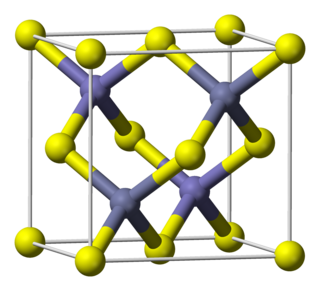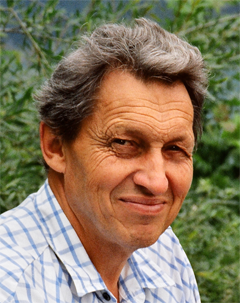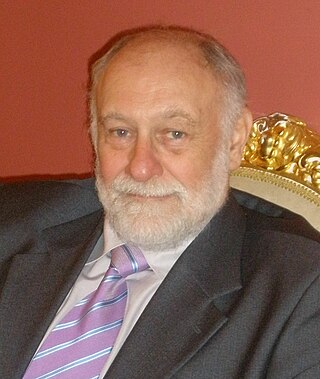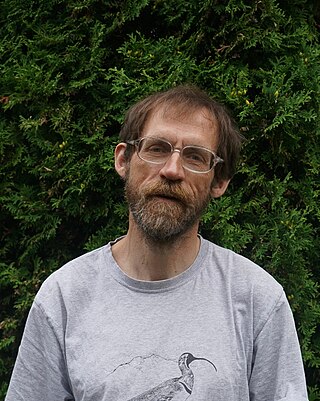A semiconductor is a material that has an electrical conductivity value falling between that of a conductor, such as copper, and an insulator, such as glass. Its resistivity falls as its temperature rises; metals behave in the opposite way. Its conducting properties may be altered in useful ways by introducing impurities ("doping") into the crystal structure. When two differently doped regions exist in the same crystal, a semiconductor junction is created. The behavior of charge carriers, which include electrons, ions, and electron holes, at these junctions is the basis of diodes, transistors, and most modern electronics. Some examples of semiconductors are silicon, germanium, gallium arsenide, and elements near the so-called "metalloid staircase" on the periodic table. After silicon, gallium arsenide is the second-most common semiconductor and is used in laser diodes, solar cells, microwave-frequency integrated circuits, and others. Silicon is a critical element for fabricating most electronic circuits.
Spintronics, also known as spin electronics, is the study of the intrinsic spin of the electron and its associated magnetic moment, in addition to its fundamental electronic charge, in solid-state devices. The field of spintronics concerns spin-charge coupling in metallic systems; the analogous effects in insulators fall into the field of multiferroics.

Indium antimonide (InSb) is a crystalline compound made from the elements indium (In) and antimony (Sb). It is a narrow-gap semiconductor material from the III-V group used in infrared detectors, including thermal imaging cameras, FLIR systems, infrared homing missile guidance systems, and in infrared astronomy. Indium antimonide detectors are sensitive to infrared wavelengths between 1 and 5 μm.
Chalcogenide glass is a glass containing one or more chalcogens. Up until recently, chalcogenide glasses (ChGs) were believed to be predominantly covalently bonded materials and classified as covalent network solids. A most recent and extremely comprehensive university study of more than 265 different ChG elemental compositions, representing 40 different elemental families now shows that the vast majority of chalcogenide glasses are more accurately defined as being predominantly bonded by the weaker van der Waals forces of atomic physics and more accurately classified as van der Waals network solids. They are not exclusively bonded by these weaker vdW forces, and do exhibit varying percentages of covalency, based upon their specific chemical makeup. Polonium is also a chalcogen but is not used because of its strong radioactivity. Chalcogenide materials behave rather differently from oxides, in particular their lower band gaps contribute to very dissimilar optical and electrical properties.
A two-dimensional electron gas (2DEG) is a scientific model in solid-state physics. It is an electron gas that is free to move in two dimensions, but tightly confined in the third. This tight confinement leads to quantized energy levels for motion in the third direction, which can then be ignored for most problems. Thus the electrons appear to be a 2D sheet embedded in a 3D world. The analogous construct of holes is called a two-dimensional hole gas (2DHG), and such systems have many useful and interesting properties.

Anatoly Ivanovich Larkin was a Russian theoretical physicist, universally recognised as a leader in theory of condensed matter, and who was also a celebrated teacher of several generations of theorists.

Dmitri Z. Garbuzov was one of the pioneers and inventors of room temperature continuous-wave-operating diode lasers and high-power diode lasers.
Richard Anthony "Tony" Stradling (1937-2002), was a notable English semiconductor physicist, latterly professor of physics at Imperial College London.
Gallium manganese arsenide, chemical formula (Ga,Mn)As is a magnetic semiconductor. It is based on the world's second most commonly used semiconductor, gallium arsenide,, and readily compatible with existing semiconductor technologies. Differently from other dilute magnetic semiconductors, such as the majority of those based on II-VI semiconductors, it is not paramagnetic but ferromagnetic, and hence exhibits hysteretic magnetization behavior. This memory effect is of importance for the creation of persistent devices. In (Ga,Mn)As, the manganese atoms provide a magnetic moment, and each also acts as an acceptor, making it a p-type material. The presence of carriers allows the material to be used for spin-polarized currents. In contrast, many other ferromagnetic magnetic semiconductors are strongly insulating and so do not possess free carriers. (Ga,Mn)As is therefore a candidate as a spintronic material.
Doubochinski's pendulum is a classical oscillator interacting with a high-frequency field in such a way that the oscillator takes on a discrete set of stable regimes of oscillation, each at a frequency near to the proper frequency of the oscillator, but each with a distinct, "quantized" amplitude. The phenomenon of amplitude quantization in this sort of coupled system was first discovered by the brothers Danil and Yakov Doubochinski in 1968–69.
Emmanuel I. Rashba is a Soviet-American theoretical physicist of Jewish origin who worked in Ukraine, Russia and in the United States. Rashba is known for his contributions to different areas of condensed matter physics and spintronics, especially the Rashba effect in spin physics, and also for the prediction of electric dipole spin resonance (EDSR), that was widely investigated and became a regular tool for operating electron spins in nanostructures, phase transitions in spin-orbit coupled systems driven by change of the Fermi surface topology, Giant oscillator strength of impurity excitons, and coexistence of free and self-trapped excitons. The principal subject of spintronics is all-electric operation of electron spins, and EDSR was the first phenomenon predicted and experimentally observed in this field.
The Rashba effect, also called Bychkov–Rashba effect, is a momentum-dependent splitting of spin bands in bulk crystals and low-dimensional condensed matter systems similar to the splitting of particles and anti-particles in the Dirac Hamiltonian. The splitting is a combined effect of spin–orbit interaction and asymmetry of the crystal potential, in particular in the direction perpendicular to the two-dimensional plane. This effect is named in honour of Emmanuel Rashba, who discovered it with Valentin I. Sheka in 1959 for three-dimensional systems and afterward with Yurii A. Bychkov in 1984 for two-dimensional systems.
Kirill Borisovich Tolpygo was a Soviet physicist and a corresponding member of the National Academy of Sciences of Ukraine. He was recognized for his works on condensed matter theory; the theory of phonon spectra in crystals; electronic structure and defects in insulators and semiconductors; and biophysics. He created the Department of Theoretical Physics and the Department of Biophysics at Donetsk National University. Tolpygo was a teacher, mentor and scientific adviser to graduate students. Tolpygo was awarded the Order of the Great Patriotic War.
Vadim Evgenievich Lashkaryov, a prominent Soviet experimental physicist, was born in Kyiv, to a family of a lawyer. He was an Academician of the National Academy of Sciences of Ukraine and is known for his fundamental contributions to physics of semiconductors.
Giant oscillator strength is inherent in excitons that are weakly bound to impurities or defects in crystals.
Vladimir Lvovich Broude, was a Soviet and Russian experimental physicist of Jewish descent. His father was a Professor of biochemistry and his mother was a medical doctor. His elder brother Yevgeny was conscripted soon after beginning of the Nazi invasion in June 1941 and lost his life.

Yuri Vladimirovich Trushin is Russian physicist and professor of Theoretical Physics of semiconductors. He is a member of the Russian Academy of Natural Sciences, and has been recognized as an Honored Scientist of the Russian Federation.
Gregory Evgenievich (Ezekielevich) Pikus was a Soviet theoretical physicist whose contributions strongly influenced developing physics of semiconductors. Among his most fundamental contributions are development of the method of invariants in band theory of solids, the Bir-Aronov-Pikus mechanism of spin relaxation of electrons, prediction of the circular photogalvanic effect, and theory of weak localization in noncentrosymmetric structures. His three monographs reflect the focus points of the theory of semiconductors during the second half of the 20th century from transistors to band theory to properties to artificial nanostructures.

Kirill Kavokin is a Russian physicist working on solid state physics, semiconductor optics and spin physics. He also works on animal vision and magnetoreception. He is currently leading scientist at the Spin Optics Laboratory (SOLAB) at Saint-Petersburg State University (SPbSU) and at the I. M. Sechenov Institute of Evolutionary Physiology and Biochemistry, in Saint Petersburg, Russia. He is the brother of Physicist Alexey Kavokin.




